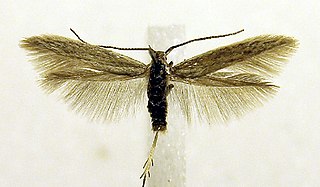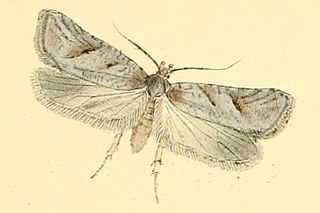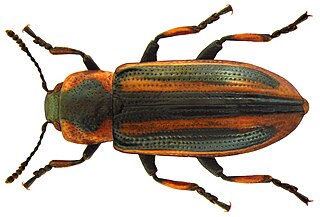
Convolvulaceae, commonly called the bindweeds or morning glories, is a family of about 60 genera and more than 1,650 species. These species are primarily herbaceous vines, but also include trees, shrubs and herbs. The tubers of several species are edible, the best known of which is the sweet potato.

Bhitarkanika Mangroves is a mangrove wetland in Odisha, India, covering an area of 650 km (400 mi) in the Brahmani River and Baitarani River deltas.

The Chrysomelinae are a subfamily of leaf beetles (Chrysomelidae), commonly known as broad-bodied leaf beetles or broad-shouldered leaf beetles. It includes some 3,000 species around the world.

The Encyclopedia of Life (EOL) is a free, online encyclopedia intended to document all of the 1.9 million living species known to science. It aggregates content to form "page"s for every known species. Content is compiled from existing trusted databases which are curated by experts and it calls on the assistance of non-experts throughout the world. It includes video, sound, images, graphics, information on characteristics, as well as text. In addition, the Encyclopedia incorporates species-related content from the Biodiversity Heritage Library, which digitizes millions of pages of printed literature from the world's major natural history libraries. The BHL digital content is indexed with the names of organisms using taxonomic indexing software developed by the Global Names project. The EOL project was initially backed by a US$50 million funding commitment, led by the MacArthur Foundation and the Sloan Foundation, who provided US$20 million and US$5 million, respectively. The additional US$25 million came from five cornerstone institutions—the Field Museum, Harvard University, the Marine Biological Laboratory, the Missouri Botanical Garden, and the Smithsonian Institution. The project was initially led by Jim Edwards and the development team by David Patterson. Today, participating institutions and individual donors continue to support EOL through financial contributions.

Coleophora boreella is a moth of the family Coleophoridae. It is found from Fennoscandia and northern Russia to the Netherlands and Poland.

Exaeretia is a moth genus of the superfamily Gelechioidea. It is placed in the family Depressariidae, which is often – particularly in older treatments – considered a subfamily of Oecophoridae or included in the Elachistidae.
The Reptile Database is a scientific database that collects taxonomic information on all living reptile species. The database focuses on species and has entries for all currently recognized ~14,000 species and their subspecies, although there is usually a lag time of up to a few months before newly described species become available online. The database collects scientific and common names, synonyms, literature references, distribution information, type information, etymology, and other taxonomically relevant information.

iNaturalist is an American 501(c)(3) nonprofit social network of naturalists, citizen scientists, and biologists built on the concept of mapping and sharing observations of biodiversity across the globe. iNaturalist may be accessed via its website or from its mobile applications. iNaturalist includes an automated species identification tool, and users further assist each other in identifying organisms from photographs. As of 9 July 2024, iNaturalist users had contributed approximately 197,660,888 observations of plants, animals, fungi, and other organisms worldwide, and 290,007 users were active in the previous 30 days.

Bryotropha boreella is a moth of the family Gelechiidae. It has a disjunct alpine-boreal distribution. It is locally common in central and northern Europe, northern England and Scotland. In Scandinavia, it is found in north-western Denmark, Sweden and Finland. It is also present in the French Alps, Germany and Austria. Records from the Ural need confirmation.

Hydrothassa is a genus of Chrysomelinae. It is sometimes treated as a subgenus of Prasocuris.

Prasocuris is a genus of Chrysomelinae.

Prasocuris junci is a species of leaf beetle native to Europe.

Prasocuris phellandrii is a species of beetle in family Chrysomelidae. It is found in the Palearctic

Prasocuris vittata is a species of leaf beetles in the family Chrysomelidae. It is found in North America.
Ectecephala laticornis is a species of grass fly in the family Chloropidae.
Opilioacarus texanus is a species of mite in the family Opilioacaridae.
Aradus implanus is a species of flat bug in the family Aradidae. It is found in North America.
Nausigaster texana is a species of syrphid fly in the family Syrphidae.
The Himalayan long-eared bat, also known as Hodgson's long-eared bat, is a species of bat in the family Vespertilionidae. It is ranges from the Indian subcontinent east to China and south to Vietnam.











